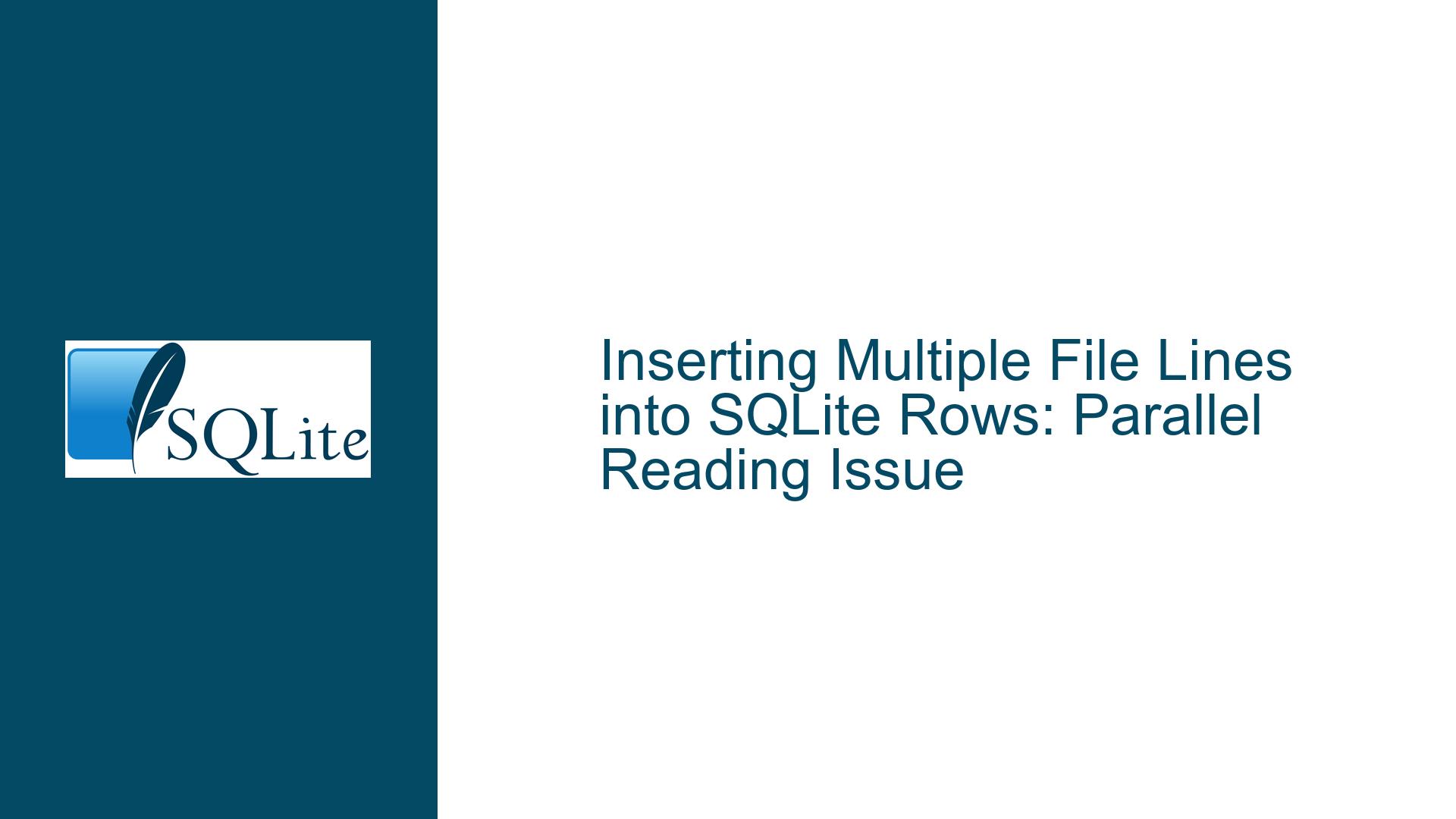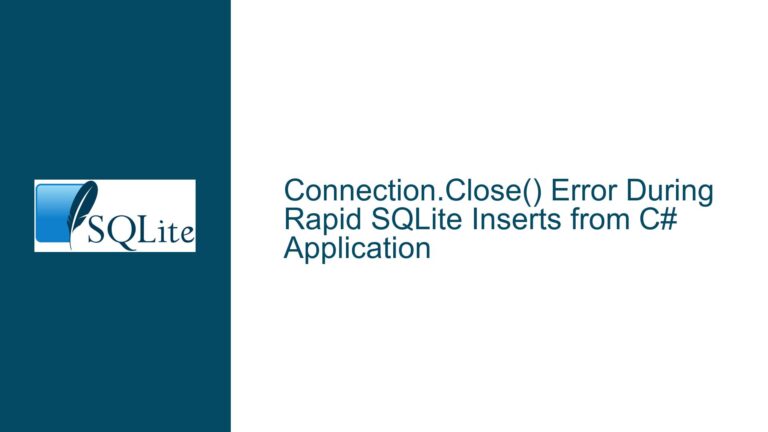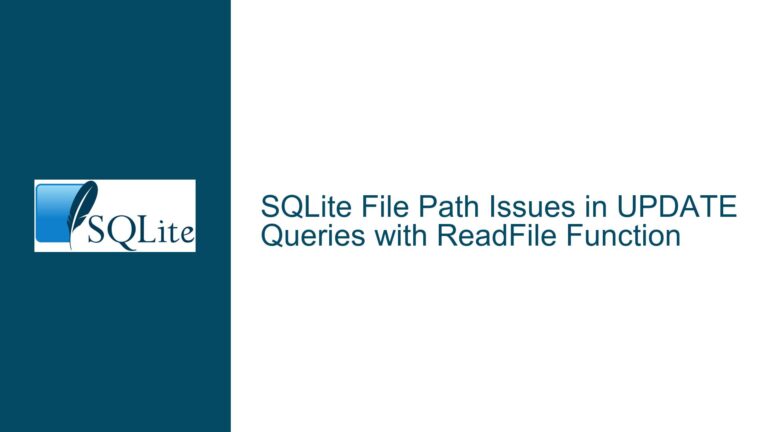Inserting Multiple File Lines into SQLite Rows: Parallel Reading Issue
Mismanaged File Iteration Leading to Incorrect SQLite Row Insertion
Issue Overview: Misaligned File Reading and Database Insertion Logic
The core challenge involves correctly reading lines from multiple text files and inserting them as corresponding rows in an SQLite database table. The original code attempts to populate a datasamples table with columns for names, colors, shapes, and favfood, using data extracted from five separate files. The user’s implementation fails to insert all lines from these files into the database. Instead, it inserts either the first or last line of each file, depending on whether a break statement is used within the file-reading loops.
Key Observations:
- File Handling Flaws: The code opens each file repeatedly inside a
whileloop that iterates 10 times. For each iteration, every file is opened, read in full (or up to abreak), and closed. This approach resets the file pointer to the start of each file during every iteration, causing redundant reads and incorrect line extraction. - Variable Overwriting: In the absence of a
break, the innerforloops iterate through all lines in each file. This results in the variables (line1,line2, etc.) being overwritten with each subsequent line, leaving them holding only the final line of their respective files when the loops conclude. - Loop Structure Misalignment: The outer
whileloop runs 10 times, but the inner file-reading logic does not track line positions across iterations. This leads to inserting the same line(s) repeatedly instead of progressing through each file’s content sequentially. - Parameter Mismatch: The SQL
INSERTstatement includes five placeholders (?), but the table schema defines only four columns (names,colors,shapes,favfood). This mismatch causes execution errors if thebreakis removed, though the user’s description suggests they encountered inconsistent row insertion rather than immediate SQL errors.
Critical Implications:
- Data Integrity Loss: Only partial data from the files is stored, compromising the dataset’s completeness.
- Resource Inefficiency: Repeatedly opening and closing files within a loop consumes unnecessary system resources.
- Scalability Issues: The hardcoded file handling (five separate
with openblocks) becomes unwieldy if the number of files or columns changes.
Root Causes: Sequential File Processing and Loop Misuse
Lack of Parallel File Iteration:
- The code processes each file sequentially within every iteration of the
whileloop. For example, it readsf1entirely before moving tof2, and so on. This prevents synchronized reading of corresponding lines across files. To insert a row containing the first line of each file, followed by a row with the second line of each file, the files must be read in parallel, not sequentially.
- The code processes each file sequentially within every iteration of the
File Pointer Reset on Reopen:
- Each time a file is opened (e.g.,
with open(f1) as j), the file pointer starts at the beginning. Without a mechanism to track the read position across loop iterations, the code repeatedly reads the same lines instead of advancing through the files.
- Each time a file is opened (e.g.,
Variable Scope and Overwriting:
- The
line1toline5variables are overwritten in each file’s innerforloop. Without abreak, these loops exhaustively read all lines, leaving the variables holding the last line. With abreak, only the first line is captured, but subsequentwhileiterations reopen the files and reset progress.
- The
Incorrect Loop Nesting:
- The outer
whileloop governs the number of rows inserted (10), while the inner file-reading loops govern data extraction. These loops are not coordinated, leading to mismatched iterations. For instance, if each file has three lines, the inner loops would process three lines perwhileiteration, but the outer loop would insert 10 rows, resulting in redundant or incomplete data.
- The outer
Hardcoded File-to-Column Mapping:
- The code explicitly opens five files (
f1tof5) but maps them to four columns (names,colors,shapes,favfood). This discrepancy suggests a typo or design oversight, potentially causing parameter count mismatches during SQL execution.
- The code explicitly opens five files (
Resolution: Synchronized File Reading and SQL Parameter Alignment
Step 1: Use Parallel File Iteration with zip
The zip function in Python allows simultaneous iteration over multiple iterables (e.g., file objects). By opening all files at once and iterating over their lines in unison, corresponding lines are grouped naturally:
with open("names.txt") as f1, open("colors.txt") as f2, open("shapes.txt") as f3, open("favfood.txt") as f4:
for name_line, color_line, shape_line, food_line in zip(f1, f2, f3, f4):
# Insert these lines into the database
Key Adjustments:
- Single Context Manager: Open all files within a single
withstatement to ensure they remain open and their file pointers advance correctly. zipfor Lockstep Iteration:zippairs the first line of each file, then the second, and so on, until the shortest file is exhausted.- Strip Whitespace: Use
line.strip()to remove trailing newline characters or spaces.
Step 2: Eliminate Redundant Loops and Variable Overwriting
Replace the nested while and for loops with a single loop over the zip result:
def import_data():
conn = sqlite3.connect("example.db")
cursor = conn.cursor()
insert_sql = "INSERT INTO datasamples(names, colors, shapes, favfood) VALUES (?, ?, ?, ?)"
with open("names.txt") as f1, open("colors.txt") as f2, open("shapes.txt") as f3, open("favfood.txt") as f4:
for name, color, shape, food in zip(f1, f2, f3, f4):
cursor.execute(insert_sql, (name.strip(), color.strip(), shape.strip(), food.strip()))
conn.commit()
conn.close()
Improvements:
- Reduced Complexity: A single loop replaces the nested
whileandforloops. - No Variable Overwriting: Each iteration of the
forloop processes a new set of lines.
Step 3: Validate and Adjust SQL Parameters
Ensure the number of placeholders in the SQL statement matches the table’s column count. The original code had five placeholders for four columns, which would cause an sqlite3.ProgrammingError. Correct the statement to use four placeholders:
# Incorrect (original):
# db_elements = 'INSERT INTO datasamples(names, colors, shapes, favfood) VALUES(?,?,?,?,?)'
# Corrected:
insert_sql = 'INSERT INTO datasamples(names, colors, shapes, favfood) VALUES (?, ?, ?, ?)'
Step 4: Handle Files of Unequal Length
If the input files have differing line counts, zip stops at the shortest file. To handle this:
- Option 1: Ensure all files have the same number of lines before processing.
- Option 2: Use
itertools.zip_longest(with caution) to fill missing values:
from itertools import zip_longest
with open("names.txt") as f1, open("colors.txt") as f2, open("shapes.txt") as f3, open("favfood.txt") as f4:
for name, color, shape, food in zip_longest(f1, f2, f3, f4, fillvalue=""):
# Insert with default values for missing lines
Step 5: Generalize for Dynamic File Handling
To avoid hardcoding filenames and columns, use lists and loops:
files = ["names.txt", "colors.txt", "shapes.txt", "favfood.txt"]
columns = ["names", "colors", "shapes", "favfood"]
conn = sqlite3.connect("example.db")
cursor = conn.cursor()
# Open all files and read lines in parallel
file_objects = [open(fname) for fname in files]
for lines in zip(*file_objects):
cursor.execute(
f"INSERT INTO datasamples ({', '.join(columns)}) VALUES ({', '.join(['?']*len(columns))})",
[line.strip() for line in lines]
)
for f in file_objects:
f.close()
conn.commit()
conn.close()
Step 6: Debugging and Validation
After refactoring, verify the results:
- Check Inserted Rows:
cursor.execute("SELECT COUNT(*) FROM datasamples") print("Rows inserted:", cursor.fetchone()[0]) - Inspect Sample Data:
cursor.execute("SELECT * FROM datasamples LIMIT 5") for row in cursor.fetchall(): print(row) - Handle Exceptions:
Wrap database operations intry-exceptblocks to catch errors like missing files or permission issues.
Final Code Example:
import sqlite3
from contextlib import closing
def import_data():
db_file = "example.db"
table_name = "datasamples"
columns = ["names", "colors", "shapes", "favfood"]
files = ["names.txt", "colors.txt", "shapes.txt", "favfood.txt"]
with sqlite3.connect(db_file) as conn:
with closing(conn.cursor()) as cursor:
# Create table if not exists
cursor.execute(
f"CREATE TABLE IF NOT EXISTS {table_name} ({', '.join(columns)})"
)
# Open all files and read in parallel
with (
open(files[0]) as f1,
open(files[1]) as f2,
open(files[2]) as f3,
open(files[3]) as f4
):
for name, color, shape, food in zip(f1, f2, f3, f4):
cursor.execute(
f"INSERT INTO {table_name} VALUES (?, ?, ?, ?)",
(name.strip(), color.strip(), shape.strip(), food.strip())
)
conn.commit()
print(f"Data imported successfully into {table_name}.")
if __name__ == "__main__":
import_data()
Summary of Fixes:
- Synchronized File Reading: Using
zipto iterate through lines of multiple files simultaneously. - Single File Opening: Keeping files open across iterations to maintain read progress.
- Parameter Alignment: Correcting SQL placeholders to match column count.
- Resource Management: Using context managers (
withstatements) for automatic file and database connection cleanup.






